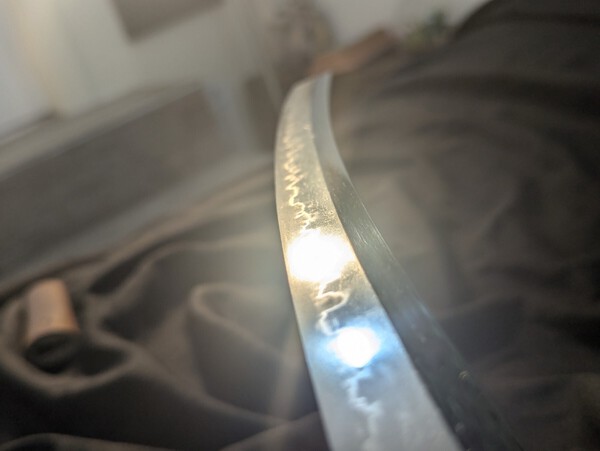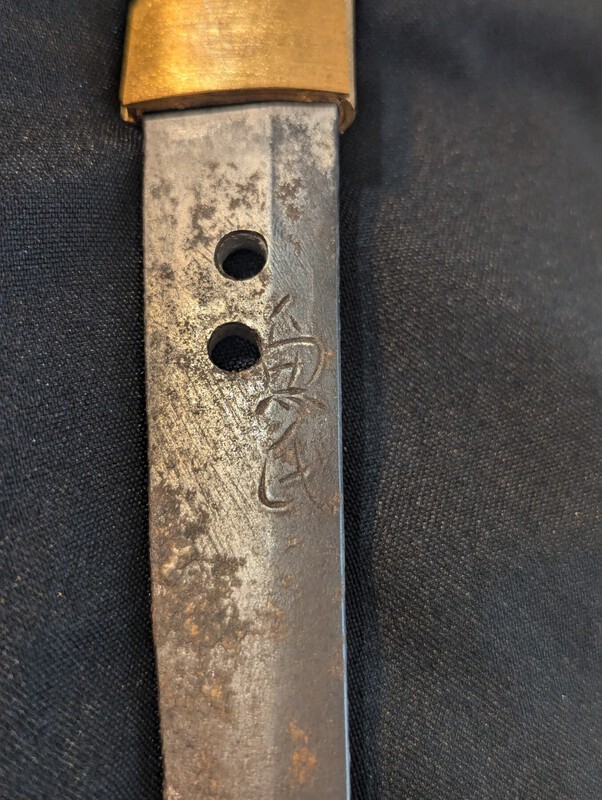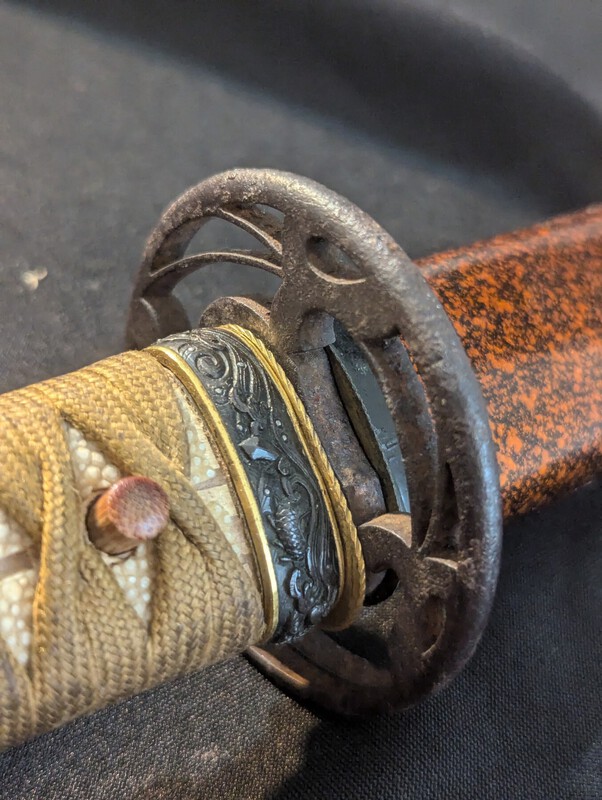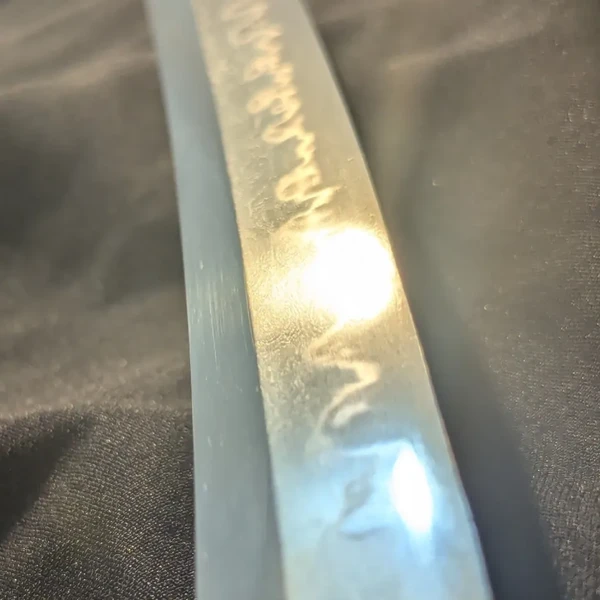-
Posts
4,936 -
Joined
-
Last visited
-
Days Won
132
Everything posted by Ray Singer
-

Muromachi Kaneuji wakizashi in koshirae
Ray Singer replied to Ray Singer's topic in Swords and Edged Weapons
-

Muromachi Kaneuji wakizashi in koshirae
Ray Singer replied to Ray Singer's topic in Swords and Edged Weapons
-

Muromachi Kaneuji wakizashi in koshirae
Ray Singer replied to Ray Singer's topic in Swords and Edged Weapons
-
Yamashiro (no) kuni ju Fujiwara Norisada
-
Yamashiro (no) kuni ju Fujiwara Norisada
-
Tadamitsu
-
Listing an elaborate wakizashi by Mino Kaneuji (Muromachi period) in shirasaya with koshirae. This is a later generation of Kaneuji from the famous Masamune smith Shizu Kaneuji, and by a smith considered to be of straighline descent from Shizu. The blade has a quite active choji-midare in ko-nie, reminiscent of So-den Bizen in places. Forging is itame-hada, and is healthy. The nakago is ubu, and signed with a nijimei of Kaneuji. Shape is shinogi-zukuri with a rarely seen marumune. This blade recently passed shinsa and kanteisho will be forwarded to the buyer of arrival of the papers. The shirasaya has a sayagaki indicating as well that this Kaneuji is of the Mino group, and there is a very nice koshirae with red lacquer saya, a sukashi tsuba which appears to be kodai Akasaka, and a signed shakudo and gold dragon fuchigashira. KANEUJI (兼氏), Tenbun (天文, 1532-1555), Mino – “Kaneuji” (兼氏), “Nōshū Seki-jū Kaneuji” (濃州関住兼氏),Muroya school (室屋), this Kaneuji was a descendant of the Kaneuji line that had once moved from Naoe to Seki and had joined there the local Muroya school, suguha, notare mixed with gunome, gunome-midare, mostly in ko-nie-deki, in some cases also in nioi-deki $4,500 + shipping and PayPal
-
金 - Kin/Kane
-
I am not sure that I would agree, Naoe Shizu is a highly respected and desirable school with many juyo. An article from Darcy below. https://web.archive....m/naoe-shizu-katana/
-

Kanemoto (another auction)
Ray Singer replied to Nick Theo's topic in Auctions and Online Sales or Sellers
Makes sense and that's not something I have seen in a recent kanteisho. Today, I think, the attribution on an NBTHK kanteisho for a koto blade which does not pinpoint a specific Kanemoto would be something like: Kanemoto (kodai) All that aside, being a sword sold at auction with only deprecated papers and suspicious appearance to the nakago, the mei should be looked at with caution. -

Kanemoto (another auction)
Ray Singer replied to Nick Theo's topic in Auctions and Online Sales or Sellers
Other reference to 別人, which does seem to be similar in intention to 'kuni fumei' or 'kodai': -

Kanemoto (another auction)
Ray Singer replied to Nick Theo's topic in Auctions and Online Sales or Sellers
Ninteisho reads 別人. Perhaps this is intended as a similar meaning to 'kuni fumei'. -

Kanemoto (another auction)
Ray Singer replied to Nick Theo's topic in Auctions and Online Sales or Sellers
It looks like the mei might be a more recent addition, and there was an attempt a repatination. Not red paint, but it's strange and suspicious that the nakago is only repaired in the area of the mei. I can vaguely see the mei in the kicho ninteisho. Please show a clear straight on view of the papers. -

IZUMINOKAMI KUNISADA
Ray Singer replied to Nick Theo's topic in Auctions and Online Sales or Sellers
Unfortunately I think you will find that this is not an authentic inscription for Izumi (no) kami Kunisada. -

IZUMINOKAMI KUNISADA
Ray Singer replied to Nick Theo's topic in Auctions and Online Sales or Sellers
You will benefit by providing the group with more, and clearer, detail photos for evaluation. Most especially a clear vertical image of the inscription -
Geoff, the translation is as I provided above. Mumei Kaifo. The does not include a notation or shinto shinshinto etc. No other information about time period is explicitly noted, however I believe Kaifu without that indicator indicates koto (Muromachi).
-
Kaifu is a school, rather than an individual. Please go through the link I shared above
-
https://www.google.c...rome-mobile&ie=UTF-8
-
Mumei Kaifu
-

How are these hamon images made?
Ray Singer replied to Fionda's topic in General Nihonto Related Discussion
This is a hand drawn representation (called an oshigata) -

is it authentic?
Ray Singer replied to William Jennings's topic in General Nihonto Related Discussion
Looks authentic. See examples below of white line. -

Interesting kogarasu maru with no nakago
Ray Singer replied to Gerry's topic in Auctions and Online Sales or Sellers
Not that I have seen. -
I have not heard that there will be a shinsa in San Francisco. Where was that information posted? The NTHK just had a shinsa in Orlando last week, so it would not be that organization.
-

Interesting kogarasu maru with no nakago
Ray Singer replied to Gerry's topic in Auctions and Online Sales or Sellers
The handle is the nakago. This is a kenuki-gata style of blade.

































